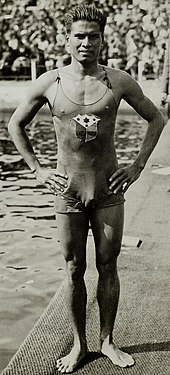1932 Summer Olympics / Participant (Philippines)
|
|
|
|
|---|---|---|
| - | - | 3 |
The islands of the Philippines took part in the 1932 Summer Olympics in Los Angeles with seven athletes . They represented the sports of athletics (high jump), swimming and boxing .
One of the athletes carried the flag into the stadium for the opening ceremony and all participants were accompanied by coaches or officials, including Regino R. Ylanan , formerly successful active athlete and now Secretary General of the Amateur Athletics Federation of the Philippines as representative of the NOC of the Philippines .
Medalist
| Name (s) | sport | competition |
|---|---|---|
| Simeon G. Toribio | athletics | high jump |
| Teófilo Yldefonso | swim | 200 m breaststroke |
| José Villanueva | Boxing | Bantamweight |
Participants by sport and their placement
overview
The athletes in the Philippines had prepared especially for the disciplines of athletics, especially jumping, as well as swimming and boxing. Women did not participate for the Philippines.
high jump
Simeon Toribio , already in 1928 participant in the Summer Olympic Games (OSS) in Amsterdam with the discipline high jump , where he achieved fourth place, jumped in the then widespread belly roll . In Los Angeles he was one of 14 participants.
The best four jumpers had all overcome the height of 1.97 m, none made the higher mark (at that time, inch increments were used). So a jump-off had to bring the decision, and that was long-lasting and exciting. The whole competition lasted four hours! In the report it says:
"[...] all tore when the bar was raised an inch, close to 2 meters. It was a fun company, but how serious it was! Every time a rival did it, van Osdel ran to him and shook his hand. Eventually the young Canadian McNaughton did the same, and at last it became a general shake hands . [...] Admirable the will and jumping power of the smaller Filipino Simeon Toribo [...]. Only in the seventh jump jump did the Canadian make it. "
Finally McNaughton won the gold medal, the silver medal went to Robert van Osdel from the USA .
Toribio also took part in the next OSS in 1936 in Berlin , where he finished 12th.
swim
 In swimming, two athletes competed in several elimination rounds, namely Jikirum Adjaluddin (1912-1938) in the 100-m freestyle swimming and 200-m breaststroke and Teófilo Yldefonso (1902-1943) also in the 200-m breaststroke.
In swimming, two athletes competed in several elimination rounds, namely Jikirum Adjaluddin (1912-1938) in the 100-m freestyle swimming and 200-m breaststroke and Teófilo Yldefonso (1902-1943) also in the 200-m breaststroke.
Adjaluddin did not get into the final fight in the freestyle, in the breaststroke he finally took 5th place in the final with a time of 2: 49.2 minutes.
Yldefonso, who learned to swim in his native river Guisit (a tributary of the Laoag ), already took fourth place when he took part in the OSS in Amsterdam in 1928. He swam in Los Angeles 2: 47.1 minutes, which brought him third place. Only the two Japanese Tsuruta Yoshiyuki and Reizo Koike , who won gold and silver , were better . At the next Summer Olympics in Berlin in 1936 , Yldefonso again achieved a good 7th place.
Boxing
Here four athletes had qualified to take part in the Olympic competitions. These were John Gray in the flyweight , José Luis Villanueva (1913-1983) in the bantamweight , José Padilla in the lightweight and Carlos Padilla in the welterweight .
Gray and José Padilla lost their fights respectively in the first round, Gray against the Italian Edelweis Rodriguez and Padilla against the South African Lawrence Stevens , both on points. José's older brother, Carlos Padilla, also lost his fight on points against Lucien Laplace from France . Villanueva reached the final fights and after a lost match against the American Joseph Lang (1911-1990) he stayed in third place.
A journalistic assessment of the Filipino fighting style states :
- They “have a strange way of fighting. They are well trained in boxing, but above all they rely on their fighting power and the effectiveness of their hits. They cannot and do not want to wait, they let their steely trained bodies drift with a brave temperament, send out shocking blows and are satisfied when some of them arrive. They don't mind being hit if they can hit themselves at the same time, because they know it will be harder and more effective. They are seldom thrown back or even stopped. They proceed with flags flying, ready to fall or fall. It is not at all unwise that the Olympic jury almost regularly sided with the good boxer rather than the daring fighter. "
Balance sheet
Overall, with a victory rate of 43 percent (three medals for seven athletes), the country balance sheet is good. All results up to 6th place are entered in the honor roll of the IOC.
literature
- Olympia 1932. The X. Olympic Games in Los Angeles 1932 , Verlag Philipp Reemtsma, Hamburg, 1932.
- John Grasso, Bill Mallon, Jeroen Heijmans: Historical Dictionary of the Olympic Movement on books.google.de.
Web links
- Official (complete) Olympic report of the IOC on the OSS 1932 : The Games of the Xth Olympiad Los Angeles 1932 (English), 840 pp.
Individual evidence
- ^ Official Olympic report of the IOC, p. 22 as well as pictures from the opening ceremony and the details of the respective sports.
- ^ Official Olympic report of the IOC , 1932 : pp. 444, 693.
- ↑ Olympia 1932 . Reemtsma, pp. 34/35.
- ↑ Tombstone of Jikirum Adjaluddin in the Philippines ; accessed on November 9, 2018.
- ^ Official Olympic report of the IOC , pp. 671–680.
- ↑ Olympia 1932 . Reemtsma, p. 120.
- ^ Official Olympic report of the IOC, from p. 803.





